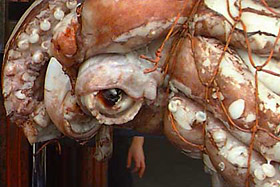 |
 |
 |
 Editorials | Environmental | September 2005 Editorials | Environmental | September 2005  
Scientists Capture Giant Squid on Camera
 Reuters Reuters


| | An ignominious end for a creature of the deep. |
Japanese scientists have taken the first photographs of one of the most mysterious creatures in the deep ocean - the giant squid.

Until now the only information about the behavior of the creatures which measure up to 18 meters (59 feet) in length has been based on dead or dying squid washed up on shore or captured in commercial fishing nets.

But Tsunemi Kubodera, of the National Science Museum, and Kyoichi Mori of the Ogasawara Whale Watching Association, both in Tokyo have captured the first images of Architeuthis attacking bait 900 meters (yards) below the surface in the cold, dark waters of the North Pacific.

"We show the first wild images of a giant squid in its natural environment," they said in a report on Wednesday in the journal Proceedings B of the Royal Society.

Little is known about the creatures because it has been so difficult to locate and study them alive. Large ships and specialist equipment, which is costly, are needed to study deep sea environments.

The Japanese scientists found the squid by following sperm whales, the most effective hunters of giant squid, as they gathered to feed between September and December in the deep waters off the coast of the Ogasawara Islands in the North Pacific.

They used a remote long-line camera and depth logging system to capture the giant squid in the ocean depths.

"The most dramatic character of giant squids is the pair of extremely long tentacles, distinct from the eight shorter arms. The long tentacles make up to two-thirds of the length of the dead specimens to date," the scientists said in the journal.

They added that the giant squid appear to be a much more active predator than researchers had suspected and tangled their prey in their elongated feeding tentacles. | 
 | |
 |



